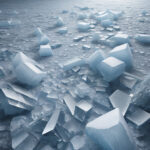A Clever Glass Trick Fixes the Decade-Old Photonic Crystal Laser Problem
Photonic-crystal surface-emitting laser (PCSEL) is a promising technology that can completely revolutionize what lasers can achieve. However, a decade-old problem has been hindering its full potential – until now. Thanks to a brilliant innovation that involves a clever glass trick, researchers have finally found a solution to this long-standing issue.
The problem with traditional PCSELs lies in their limited efficiency and output power. This has been a major roadblock in utilizing these lasers for various applications, including telecommunications, sensing, and medical devices. Despite numerous attempts to enhance their performance, progress has been slow due to the complex nature of the photonic crystals used in these devices.
Enter the groundbreaking research conducted by a team of scientists from leading universities and research institutions. By incorporating a novel approach that involves manipulating the properties of glass at the nanoscale level, they have managed to overcome the limitations of conventional PCSELs. This innovative technique allows for greater control over the emission properties of the laser, resulting in significantly improved efficiency and power output.
The key to this breakthrough lies in the unique ability of specially engineered glass to manipulate the flow of light within the PCSEL structure. By carefully tailoring the composition and structure of the glass layers, researchers can now fine-tune the interactions between light and the photonic crystal, leading to enhanced performance. This not only boosts the overall efficiency of the laser but also enables it to operate at higher power levels than ever before.
One of the most exciting aspects of this new development is its potential impact on a wide range of industries. For example, in telecommunications, the improved efficiency of PCSELs could lead to faster data transmission rates and greater bandwidth capacity. In the field of sensing, the enhanced power output could enable more sensitive and accurate detection of various substances. Medical applications could also benefit from this technology, with potential uses in precision surgery and diagnostics.
Furthermore, the scalability of this innovative glass-based approach opens up possibilities for mass production of high-performance PCSELs at a lower cost. This could make these advanced lasers more accessible to a broader audience, accelerating their integration into real-world applications.
As with any groundbreaking research, further development and optimization are still needed to fully harness the potential of this new technology. However, the initial results are promising, offering a glimpse of what the future holds for photonic-crystal surface-emitting lasers. With continued innovation and collaboration, we can expect to see even more remarkable advancements in the field of laser technology in the years to come.
In conclusion, the clever glass trick that addresses the decade-old photonic crystal laser problem represents a significant milestone in the evolution of laser technology. By pushing the boundaries of what is possible with PCSELs, researchers have paved the way for a new era of innovation and discovery. The future looks bright for these advanced lasers, with endless possibilities waiting to be unlocked.
innovations, laser technology, research, glass manipulation, efficiency#technologicaladvancements, light manipulation












